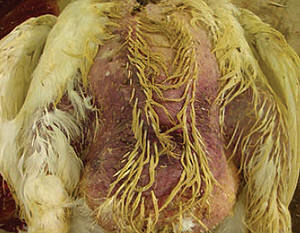
Roney: 'We've faced challenges with gangrenous dermatitis'
 "Once the birds had been on the vaccine for 35 days, we had no more dermatitis."
"Once the birds had been on the vaccine for 35 days, we had no more dermatitis."
DR. STEVE RONEY
Researchers are making significant
strides in understanding the mechanisms
behind gangrenous dermatitis in poultry.
But while researchers continue experimenting
in their labs and making observations
at posting sessions, broiler growers
are learning about GD, too—practical
and sometimes tough lessons from
their day-to-day operations.
At the Intestinal Health meeting in
Orlando, Dr. Steve Roney, formerly
director of veterinary services, eastern
region, Gold Kist, Inc., and now a US-based
veterinary consultant, said he
has faced challenges with gangrenous
dermatitis on nearly a daily basis for
much of the past 7 or 8 years. "It's one
of the most complicated syndromes I've
ever dealt with."
Experience with larger birds
Roney first discussed some experiences
he had with a complex that grew primarily
large birds. The operation was having problems
with GD and Roney was writing two or
three penicillin prescriptions weekly.
"This is a complex that was moving 1.8
million birds a week," he added. "We
were losing overall a 0.25% livability due
to gangrenous dermatitis. That's 4,500
chickens per week. So that disease alone—without any of the other costs of growing
the chicken—was costing us $10,000
each week."
The birds had been on a nicarbazinionophore
shuttle program before Roney
decided to switch to Coccivac-B in the
early spring.
"Our last case of dermatitis was in one
of the birds that was on the nicarbazinionophore
program," he said. "Once the
birds had been on the vaccine for 35 days,
we had no more dermatitis."
Roney reminded the audience that the
move to coccidiosis vaccine was made in
April, just as the environmental challenge from weather was easing. "So, would it
have stopped anyway? I don't know.
But we've seen over and over that these
things happen when we move to the
coccidiosis vaccine."
The veterinarian said one explanation
could be that in shifting coccidia cycling
to earlier in the bird's life, there is less
stress on the bird later, making it less
vulnerable to GD.
Antibiotics posed challenges
At one plant that produced three different
sized birds, the use of antibiotics posed
challenges. "We have run vaccine on the
birds that are 3.90 lbs. in weight. We find
that if we don't fortify the diet early with
protein we lose about 3 points in feed
conversion," which he thinks is a viable
approach if ionophores are losing efficacy.
Generally, however, the company is steering
away from 3.90-pound (1.77 kg) birds until more is learned about how to fortify
their diets and maintain feed conversion
when changes are made in their program.
"But anything over 4.40 pounds (2 kg) is
fair game right now," Roney added.
Under the present strategy, the complex
utilizes a coccidiosis vaccine every year
for two to three cycles; the program varies
depending on the size of bird. He said the
approach has worked well. "It's helped us
keep our ionophores in much better shape
than they would have been, in my opinion."
Another complex operated by the company
had been utilizing a rotation program of
ionophores for years, but Roney said that
within the first cycle the houses would
break with Eimeria tenella and with
E. maxima. That operation produced a
colored bird, and he said he and his team
had initially been very reluctant to add
coccidiosis vaccine to the program,
thinking it might cause a loss of color in
the birds.
"But it got to the point where we had no
choice," he said. "A lot of things you do it's
because you have no choice."
Coccivac-B was added to the program. In
addition, they decided to include a three quarter
dose of roxarsone, the arsenic
derivative anticoccidial, but only in the
grower ration. Their reasoning was that the
drug wouldn't be needed in any other ration
because it was summer and the birds they
were dealing with were large.
The results?
Gangrenous Dermititis

Though GD manifests primarily on the skin,
many researchers are convinced intestinal
factors play a role in its etiology.
"Lo and behold, we lost no color—we
never had a complaint about that," Roney
said. "And the birds had some of the best
performance they've ever had."
Roney said the complex is now using
coccidiosis vaccine on a yearly basis.
Testing the coccidia-cycling theory
Roney and his colleagues then wondered
what factors were causing these decreases
in the incidence of gangrenous dermatitis.
Was it an indirect benefit of using the
coccidiosis vaccine? Did vaccination shift
the cycling of oocysts back a few days,
therefore taking away the 30-day challenge
from the birds? And, if that were so, might
the same results be obtained using an
in-feed anticoccidial instead of the vaccine
to thwart that late coccidiosis challenge?
To find out, Roney decided to take a different
approach. Instead of using the vaccine to shift the coccidiosis cycle, he instead
added the anticoccidial Clinacox
(diclazuril). "We put it in for 7 days in the
first withdrawal," he added. "Based on the
posting sessions we'd had, that seemed to
be where we were getting the heaviest
challenge from E. maxima."
When the birds reached about 35 days,
problems with gangrenous dermatitis
subsided. Roney emphasized, however, that
other factors might have played a
role in the decrease of GD.
"We had made a minor change in the feed—removed some bakery byproduct," he
said. It is difficult to know for certain
whether the byproduct was contributing to
the problem, he added, because another
broiler complex—one that did not have
problems with dermatitis—was also using
the bakery product. He thinks the reduction
in incidence of GD could have been due to
a combination of factors.
Spring 2008
Back to North American Edition (#1)











